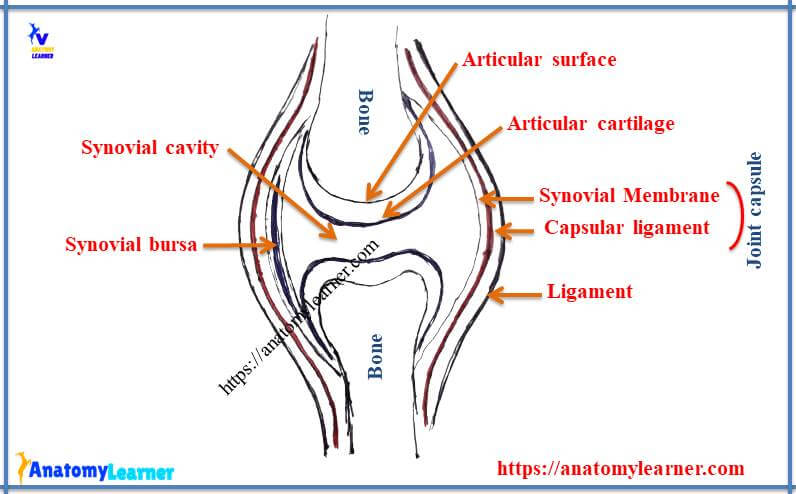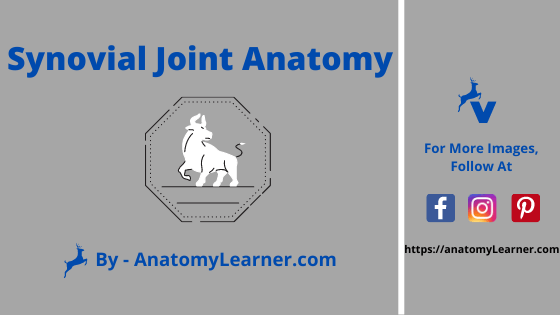You know, there are three types of joints in animal body – fibrous, cartilaginous, and synovial joints. The synovial joint is a moveable or true joint in an animal’s body.
Hi there, do you want to learn synovial joint anatomy in animals? Fine, in this article, I will describe the synovial joint structure with a labeled diagram. I will also describe different types of synovial joints in animals.
After reading this article, you will know the different structures of synovial joints in detail. You will also find a list of synovial joints examples from animal’s bodies.
So, if you are interested to know about the synovial structure, then continue this article.
Synovial joint anatomy
Other names of synovial joints are diarthrodial or moveable, or true joint. These joints are usually formed by articular cartilage, joint capsule, and different types of ligaments. You will find a joint cavity with the synovial membrane in a joint capsule.

Structure of a synovial or moveable joint
Ideally, you will find the following structure in moveable joint anatomy in animals. Let’s find these synovial structures from the labeled picture –
- #1. The articular surface of joint
- #2. Articular cartilage of synovial structure
- #3. Articular capsule
- #4. Capsular ligament (external layer of articular capsule)
- #5. Synovial membrane or synovial layer (internal layer of articular capsule)
- #6. Different types of ligaments
- #7. Articular discs and menisci of synovial joint structure
- #8. Marginal cartilage of synovial structure
Now, I will discuss on these structures of a moveable joint in animals.
Articular surface of synovial anatomy
You know, in any joints of animal body, there are articular ends of bones. In synovial joint, the articular ends or surface is smooth (in most of cases). These articular surfaces are formed of special dense bone (compact bone).
You may find some interruption (non-articular cavities) in the articular surface known as synovial fossae. This articular surface of animal synovial structure covers with the articular cartilage.
Articular cartilage structure
The articular cartilage is usually hyaline type and forms the cover over articular surface of bone. The thickness of articular cartilage varies in different types of synovial joint anatomy in animal. The thickness is more where more pressure and friction occurs in the joints of animals.
It is also smooth and non-vascular that have bluish tinge color in a fresh state. The articular cartilage derives its nutrition from the synovial membrane’s vascular network, synovial fluid, and blood vessels of underlying marrow space. It diminishes the effects of concussion and significantly reduces the friction of joints.
Articular capsule of synovial joint anatomy
This articular capsule of synovial joint anatomy is a membranous tube like a sac. The articular capsule structure is attached around the articulating surface of the concerned bones of the joint. You will find two layers in the articular capsule of synovial anatomy – external fibrous tissue layer and internal synovial membrane.
The external fibrous tissue is also termed as the capsular ligament attached to either slide of margin of articular surfaces of the bones. Thickness may vary, and you will find more thicken capsules where the bone or cartilage developed.
You know,The synovial membrane is a thin membrane that rich in blood vessels and nerves. It frequently forms folds and villi that contain pads of fats.
This synovial membrane lines the joint cavity except where the articular cartilage bounds this. The synovial membrane secretes fluid called synovia that lubricates the animal joints.
You will find a synovial bursa, a sac like structure that contains synovial fluids. This synovial bursa occurs at the site of friction in between tendon and a bone or subcutaneously over a bony prominence.
Different types of ligaments
You know ligaments are the strong bands or membranes composed of white fibrous connective tissue and bind animal bones together. These ligaments are pliable but inelastic, except for the nuchal ligament.
You will find periarticular, intraarticular, and extracapsular ligaments in a synovial joint anatomy structure. Periarticular ligaments surround the joint margin, adjacent to the joint capsule. Intra-articular ligaments find within the joint cavity covered by synovial membrane. Again, the extracapsular ligament blended with or form part of the fibrous capsule of synovial joint structure.
Generally, you will find the following types of liagemnts in a synovial structure –
#1. Collateral ligament of synovial structure
#2. Interosseous ligament of synovial anatomy
#3. Annular ligament of synovial structure
Collateral ligament located on the slide of synovial joint structure in animal. The interosseous ligament connects directly against the surface of the bones. Again, the annular ligament appears in the form of rings or tunnels.
Articular discs or menisci
These are the fibrocartilage or dense fibrous connective tissue structure located between the articular cartilage of a synovial structure. Articular discs divide the joint cavity partially or entirely into two compartments.
Marginal cartilage features
It is also the fibro-cartilage ring-like structure found in the synovial anatomy. It encircles the rim of an articular cavity of a joint. The primary function of marginal cartilage of the synovial structure is to enlarge the joint cavity to prevent the margin’s friction.
Synovial fluid
Synovial fluid is a lubricant fluid secreted by the synovial membrane and resembles the egg albumin. This fluid consists of albumin, mucin, salts, water, and hyaluronic acids. Again, the viscosity of synovial fluid depends on the concentration of hyaluronic acid.
Types or classification of synovial joint
So, do you want to know about the different types of synovial joints in animal? Great, now I will provide little information on different types of synovial structures. According to the axes of movement, these synovial joints are classified as follow –
- #1. Hinge joint (Uni-axial)
- #2. Pivot or trochoid (uniaxial joint)
- #3. Condylar joint (biaxial)
- #4. Ellipsoidal joint (biaxial)
- #5. Saddle joint (biaxial)
- #6. Ball and socket joint (multiaxial type)
Hinge and pivot joints are uniaxial joint, condylar, ellipsoidal and saddle are biaxial type joint. Again, ball and socket is a multiaxial type joint.
#1. Uniaxial joint – rotation occurs in one axis. Example – hinge joint: elbow joint in animal, Pivot joint: atlantoaxial joint in animals
#2. Biaxial joint – rotation occurs around two horizontal axes at the right angle to each other. There is no axial rotation occur in the biaxial joint in animals. Example of biaxial joint: Condylar joint: knee joint; Ellipsoidal joint: carpal joint in animals; saddle joint: a carpometacarpal joint in animals.
#3. Multiaxial joint – the circumduction and axial rotation are permitted in the multiaxial joint. These types of joints are also known as ball and socket joint or spheroidal joint. Example of ball and socket joint – shoulder joint and hip joint in animals.
If you want to know more about the synovial joint classification in detail, you may read a related article from anatomy leaner.
You might also know the different types of movement of synovial joints in animals. The movements are – gliding movement, angular (flexion, extension, abduction, and adduction movements), circumduction, and rotation movement.
Example of synovial joints
Synovial joints are the universal joints of the animal’s body. You will find different types of moveable joints in limbs of animals. I am going to enlist the true or moveable joints from animal body.
#1. Hip joint in animal
#2. The shoulder joint in animal
#3. Carpal joint in animal
#4. Femoropateller joint in animals
#5. The knee joint in animals
#6. Carpometacarpal joint in animals
#7. Elbow joint in animals
If you want to know different animal joints with their bone involvement, this article might help you.
Synovial anatomy diagram
Now, I will show you the different parts of synovial anatomy with a labeled diagram. Here, I showed you all the structures found in an ideal synovial structure in animals. If you want, you may follow this movable joint anatomy structure.
Again, if you want to get different types of a labeled diagram like true joint diagram then, you may follow anatomy learner on social media. You will get lots of updated labeled diagrams of different organs of animal’s body.
You might also like the other article related to veterinary anatomy (osteology, syndesmology) from anatomylearner.
#1. Identification of animal bones with labeled pictures
#2. Details osteological features of animal vertebrae with real images
Conclusion
This is the best guide to know the synovial joint anatomy in animals. I think this guide might help you to understand the structure of synovial joints.
If you like this article, share it with your friends who want to learn the animal joints anatomy. Don’t forget to follow the anatomy learner blog and read articles from anatomy learner.

